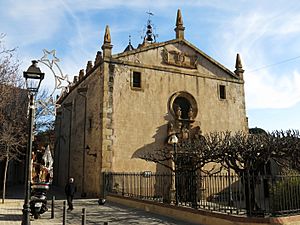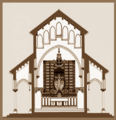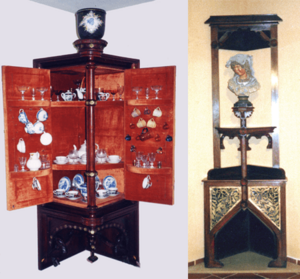Altarpiece of Alella facts for kids
The Altarpiece of Alella is a special design by the famous Catalan architect Antoni Gaudí. It was meant for a chapel in the Sant Feliu church in Alella, a project Gaudí started in 1883.
This altarpiece became known thanks to a drawing found in 1959. The drawing, made with India ink, showed Gaudí's signature. It was first published that same year. Later, a copy of the drawing was included in a book about Gaudí by George R. Collins. This book was very important because it was the first one in English about Gaudí, helping his work become famous around the world.
The drawing shows a cross-section of a chapel that would have been attached to the Sant Feliu church. The altar and its altarpiece were planned for the back of the chapel, behind a pointed arch with seven stained-glass windows. The altarpiece itself looked like a flat panel with a strong Gothic style. It featured sculptures and a main scene showing the crucifixion under a canopy.
Even though the Bishop of Barcelona approved Gaudí's plan, neither the altarpiece nor the chapel were ever built. Another design was used for the chapel instead. However, Gaudí's original drawing has been shown and copied many times.
In 1997, the Town Hall of Alella asked for the altar and chapel to be rebuilt using Gaudí's design. This was done with computer programs. This work was part of an exhibition called Gaudí i Alella in 1999. The exhibition included a model of the chapel and the altarpiece.
What it Looks Like
The altarpiece is a square panel placed on a pedestal. The pedestal is decorated with pointed arches and a patterned strip (frieze) showing plants and angels. In front of it is the altar, which also has a pointed arch shape.
In the middle of the altarpiece is a sculpture of the crucifixion. This shows Christ on the cross. Around him is an almond-shaped design with rays of light coming out. Above this, there's a delicate Gothic canopy shaped like a small temple. Guardian angels are placed within this canopy. The altarpiece is topped with a cover that has sharp slopes and a tall, thin cross.
The large main panel of the altarpiece has a delicate border. It is divided into four columns. On these columns, the word Sanctus (which means "Holy") is repeated 36 times.
In Gaudí's plan, the altarpiece was in the back of the chapel. It was in front of an arch with seven stained-glass windows. These windows had figures of angels. The chapel itself was designed with a pointed roof over wooden beams. These beams were supported by ribbed pointed arches. This style, with diaphragmatic arches and wooden beams, is typical of Catalan Gothic architecture. You can see it in places like the Royal Chapel of Santa Águeda in Barcelona.
Hidden Meanings
In 1983, an expert named Joan Bassegoda Nonell explained the hidden meanings (symbolism) of this project. He said it was based on the Apocalypse of St. John from the Bible.
For example, the seven angels in the chapel's windows are mentioned in Chapter 8, Verse 2 of the Apocalypse. It says: "I saw seven angels standing before God, to whom were given seven trumpets."
In Chapter 4, St. John describes seeing four creatures – a lion, a bull, an eagle, and a man. These creatures repeat a prayer day and night: Holy, Holy, Holy, is the Lord Almighty, who was, who is and who will come. On each of the four columns of the altarpiece, the word Sanctus is written nine times. This equals four times three repetitions of the triple prayer, symbolizing this part of the Apocalypse.
The main scene on the altar is the crucifixion. It shows Christ on the cross with the Virgin Mary and St. John on either side. This group is sometimes called the Horizontal Trinity. The figures stand in front of the almond shape, where rays of light come from Christ's head. This forms an Elliptical Aura, which is a symbol of glory and being raised to a divine level.
So, the entire design of the chapel and altarpiece directly symbolizes the crucifixion. It also interprets parts of the Apocalypse of St. John. Gaudí had used the word Sanctus before in a drawing for a reliquary (a container for holy relics). The next year, he used it again in the stained-glass windows of the crypt of the Sagrada Família temple. Bassegoda also noted that a gate Gaudí designed for a cemetery in 1875 had many symbols from the Apocalypse.
- Reconstruction project for the chapel and altarpiece of the Crucifixion for the parish church of Alella. Project carried out by Joan Bassegoda Nonell, Bibiana Sciortino and Mario Andruet, architects.
Other Gaudí Designs in Alella
Gaudí became good friends with Manuel Vicens Montaner. This was after he designed the famous Casa Vicens in Barcelona for him. Because of this friendship, Gaudí spent many summers in the 1880s at the Vicens family's home in Alella.
Gaudí designed two pieces of furniture for this house. They stayed there for many years while Mr. Vicens' daughter lived there. One is a corner fireplace made of wood and metal. It has a large sculpture on a tall stand. The initials M.V. for Manuel Vicens are on a metal plate. This fireplace is now displayed in the Casa Vicens.
The other piece of furniture is a hanging wooden corner cabinet. It is decorated with gold metal designs. The inside of the doors has shelves to make the small cabinet more useful. This cabinet is now in a private home in Barcelona. It has the initials D.G. for Dolors Giralt, Mr. Vicens' wife.
There is another item in the parish church of Alella that might have been designed by Gaudí. It is the first part of the staircase in the Romanesque bell tower. This bell tower is considered the most important of its kind on the coast of Catalonia. The bottom part of its staircase was changed. It was given a curved shape with broken triangular steps. This design allows each step to cover two heights. This is a Gothic system described by Viollet-le-Duc. It allows stairs to be very steep, up to 45 degrees. Gaudí is believed to have improved this system, which was usually only for straight stairs.
Around the same time, Gaudí was building a similar staircase in the stables of the Güell Pavilions. This makes it very likely that he also designed the one in the Alella bell tower. Gaudí also planned stairs with the same design for the waterfall in the Parc de la Ciutadella in Barcelona. He worked on this project with Joan Fontseré. In that case, the stairs were made of metal, while the other two are made of bricks.
Finally, a wrought iron cross next to the altar in the Alella church may also be linked to Gaudí. Its shape is similar to the cross Gaudí drew in his design for the Crucifixion altar. Experts believe he designed this cross too.
See Also
 In Spanish: Retablo de Alella para niños
In Spanish: Retablo de Alella para niños
- Antoni Gaudí
- Art Nouveau
- Modernisme
- Arquitectura de Barcelona (in Spanish)
- Güell Pavilions
- Casa Vicens
- Eugène Viollet-le-Duc








